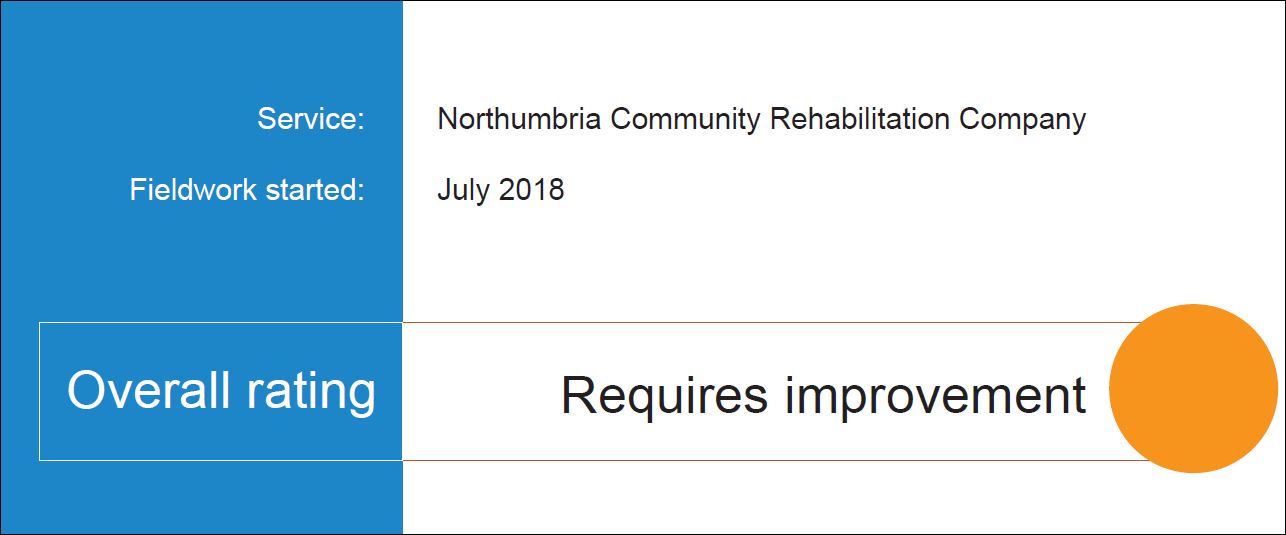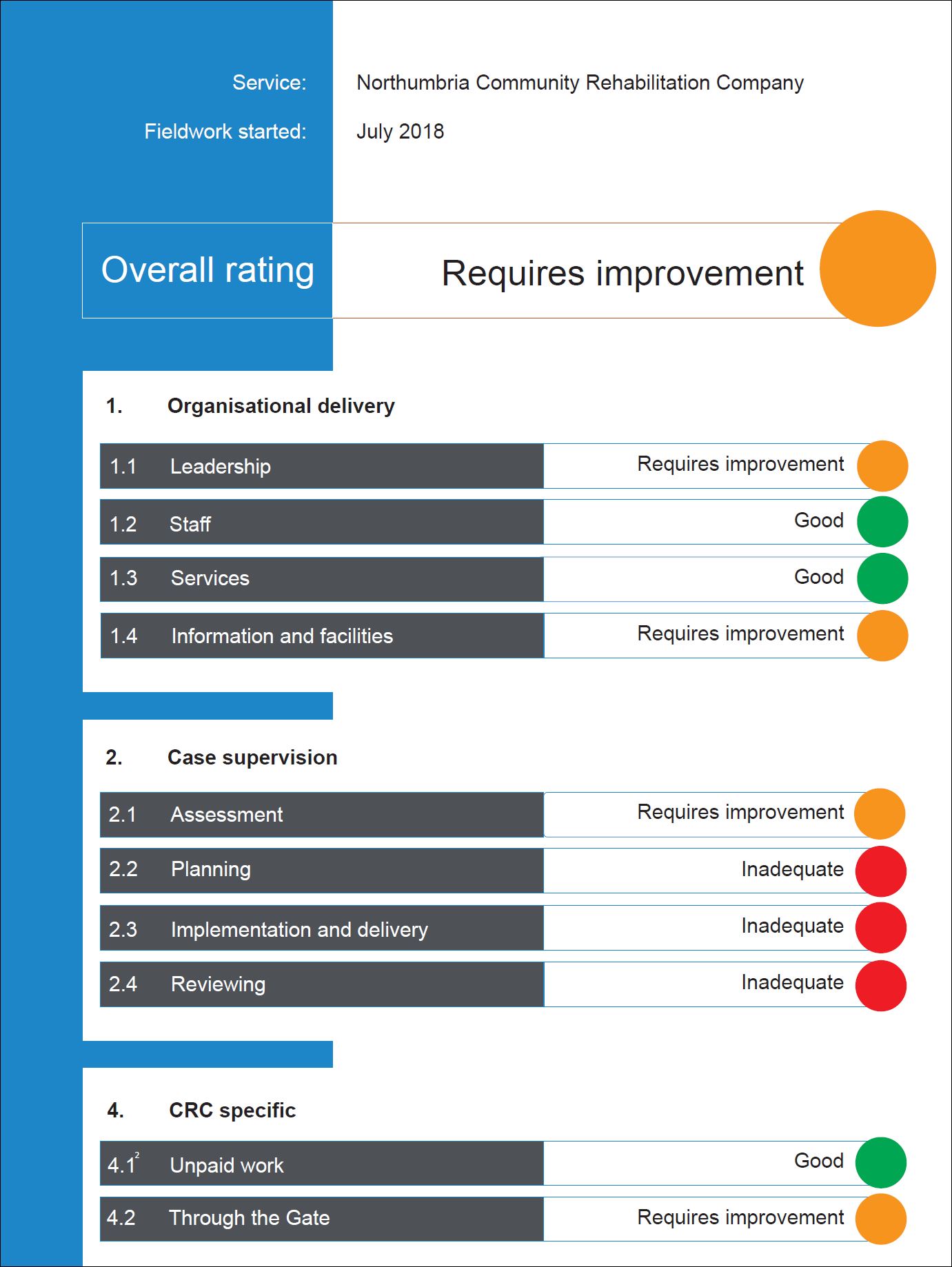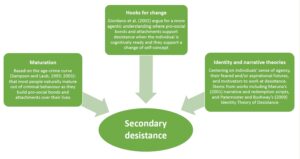Not balancing rehabilitation with public protection
Northumbria Community Rehabilitation Company (CRC) needs to improve its work to protect potential victims of those it supervises, particularly in its many domestic abuse cases, according to inspectors in a report published today.
HM Inspectorate of Probation found clear strengths in the CRC’s work to support people to recognise and tackle the reasons for their offending. It also had experienced staff with strong local partnerships and dedicated ‘champions’ for women, who made up nearly one fifth of its caseload.
However, these strengths were undermined by weaknesses in its planning to protect potential victims, which was described as poor, leading inspectors to assess it overall as ‘Requiring Improvement.’
The Northumbria report, published by Dame Glenys Stacey, HM Chief Inspector of Probation, noted that some of its problems stemmed from factors not all within its control – including difficulties for Northumbria and other CRCs owned by Sodexo linking their assessment tools with the Ministry of Justice’s national case management system and existing national assessment tool, which gather information from a range of sources. However, there were also weaknesses at local level, particularly relating to domestic abuse.
“Home visits were not reliably implemented to enhance risk management where needed. Domestic abuse featured in almost half of the case sample, but we found insufficient attention paid to actual or potential victims in almost two-thirds of relevant cases. This chimes with the findings from (HMIP’s) recently published thematic report on domestic abuse.” Inspectors found instances where the collection of child safeguarding information should have been made use of more thoroughly in the planning and reviewing of domestic abuse cases.
Dame Glenys recalled that in her annual report in 2017, she had commented: ‘In about half of all CRC cases we have inspected, not enough attention was given to risk of harm right from the beginning, and we find that lack of focus continuing through the period of supervision in a similar proportion of cases’. Disappointingly, she added, “that finding is repeated again for Northumbria CRC.”
Overall, Dame Glenys said: “Despite a stable, experienced workforce and strong, effective local partnerships, the quality of this CRC’s work is undermined by a lack of sufficient attention to managing risk of harm.” The CRC has developed its own ‘workaround’ processes which have led it to concentrate on issues linked to reoffending to the detriment of managing risk of harm and keeping others safe.
“Experienced probation workers should strike the right balance between rehabilitation and public protection intuitively, but here, systems and other pressures are influencing that judgement unduly. This requires attention at all levels. The commitment we found to achieving high performance, combined with loyal, skilled staff and partners, provides the right ingredients for addressing this and other areas for improvement.”
Key findings
Inspectors organised their key findings under three main headings: organisational delivery; case supervision and unpaid work & through-the-gate.
Organisational delivery
Inspectors’ main findings on this domain were mixed:
- The two key ingredients of quality services – addressing reoffending needs and managing risk of harm – are not well integrated in Northumbria. This has a detrimental effect on the quality of safeguarding and risk management practice.
- Northumbria CRC benefits from a cohesive, supportive and experienced workforce with a low staff turnover and many experienced staff. There are good training and development opportunities.
- A wide range of interventions are available, enhanced by effective working relationships with operational partners.
- Technology supports the delivery of services, but premises are not always designed to meet diverse needs.
Case supervision
Inspectors were generally very critical about the core probation task of supervising offenders:
- Assessment of individuals’ needs in order to reduce the risk of harm and of reoffending does not consistently draw on all sources of information available.
- Planning addresses the reasons why someone offends, but it does not include sufficient arrangements to keep others safe.
- An impressive range of services is available to deliver court orders, but practice is let down by an insufficient focus on keeping people safe during implementation and delivery.
- Reviewing focuses on whether staff have complied with processes. Practice is weak in relation to ensuring that necessary measures are in place to keep people safe.
Unpaid work and through-the-gate
- Unpaid work is well organised, and communication between unpaid work staff and responsible officers at the local management centre level is effective.
- CRC staff, operational partners and prison staff work together effectively to develop Through the Gate services, which require further improvement.
Conclusion
The Probation Inspectorate works on a four-band rating system: excellent, good, requires improvement and poor. This is the fourth inspection of a CRC under the new rating system and all four areas (Northumbria, West Yorkshire, Merseyside and Essex) have been rated in the third band: “requiring improvement”.
In all four reports, there is a sense that CRCs are becoming more robust, have resolved some of their organisational and structural problems and have a clearer strategic direction. What concerns me most is that inspectors are still finding core practice (with the noticeable exception of unpaid work) to be sub-standard.
Given that the primary focus of most CRCs over the next fifteen months will be the MoJ’s re-procurement process, they may struggle to keep their attention on the much-needed job of improving their main business – promoting desistance and protecting the public.









